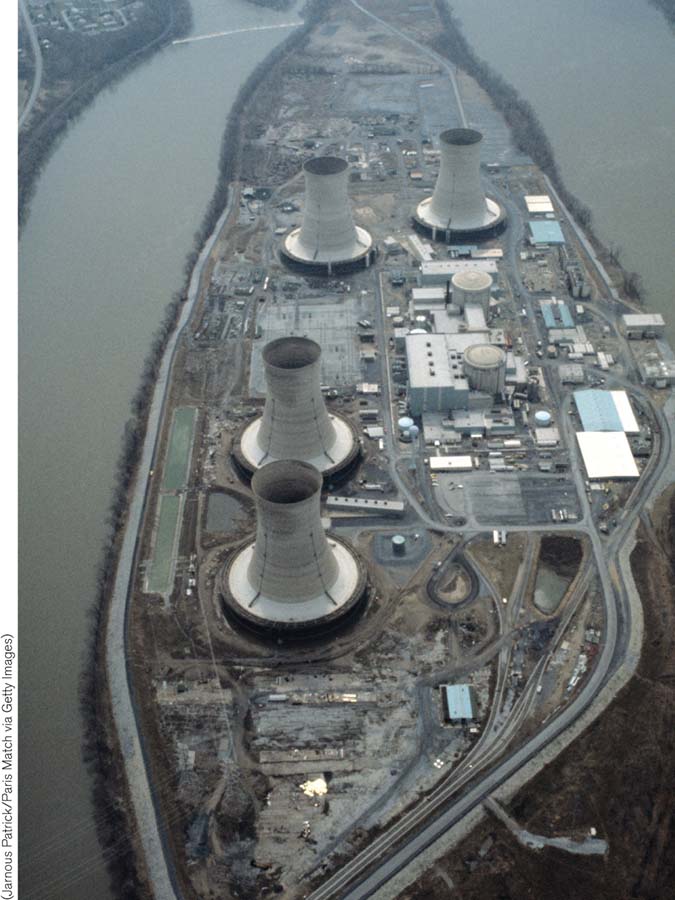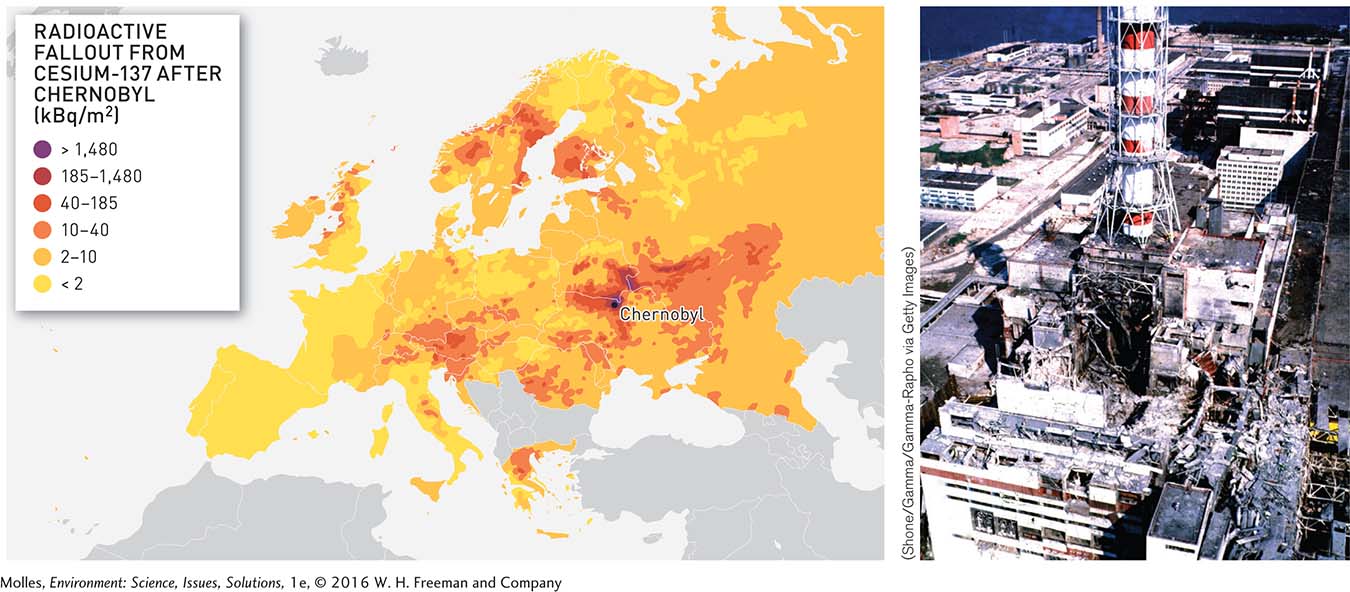9.6 Nuclear power development comes with environmental costs
During the early years of the atomic age, nuclear power was championed as a nearly infinite source of cheap and clean energy. “Our children will enjoy in their homes electrical energy too cheap to meter,” the head of the U.S. Atomic Energy Commission confidently declared in 1954. But in the 1960s and 1970s, a coalition of environmentalists rallied against the use of nuclear power because of issues related to uranium mining, radioactive waste disposal, and the risk of a nuclear accident. Even as some pundits today continue to predict a “nuclear renaissance” in response to rising petroleum prices, we have come no closer to solving these environmental issues.
Uranium Mining
Grand Canyon National Park sits right in the middle of the country’s richest deposits of uranium ore. Beginning in 1944, over 3.9 million tons of uranium were extracted from over 1,000 mines in the region, and the low-
Uranium mining, which can be conducted underground or on the surface, poses many of the same environmental threats as coal mining, but with the addition of radioactivity, which can cause cancer and other ailments. Although mine waste typically has a very low level of radioactivity, there are over 15,000 mine sites in the western United States and they are not regularly monitored. Members of the Navajo Nation, where much of this mining has occurred, argue that long-
Uranium mining accidents also have the potential to seriously damage the environment. In July 1979 a waste pond at a uranium mill in Church Rock, New Mexico, breached its dam. Over 1,000 tons of acidic, radioactive mining waste flowed into the Puerco River, contaminating water supplies used for watering livestock. Church Rock has been called the biggest radioactive accident in U.S. history.
Radioactive Waste Disposal
Each step in the process of turning uranium ore into enriched fuel rods generates a significant amount of waste. However, most of the front-
Even though the United States has been generating nuclear power for decades, we still have no safe system for the long-
Unfortunately, no country currently has a viable system in place for long-
Nuclear Meltdowns
The worst type of accident that can happen at a nuclear power plant is called a meltdown. A meltdown occurs when the core of a nuclear reactor grows too hot and begins to melt, a situation that could lead to the release of radiation into the environment.
This nightmare scenario happened in March 1979 at Pennsylvania’s Three Mile Island nuclear power plant. A valve got stuck inside, which led to the loss of coolant from the nuclear reactor (Figure 9.27). Fortunately, the reactor was contained in a strong confinement structure and plant operators acted quickly to minimize the release of radioactive material into the environment. This event, which was considered a partial meltdown, stoked public fears about the threats of nuclear technology. The reactor was too badly damaged to resume operations, and cleanup from the accident took 14 years and cost $1 billion.

A second nuclear accident further heightened doubts about nuclear power safety. In the early morning hours of April 26, 1986, a test of emergency systems at the Chernobyl power plant in Ukraine resulted in a steam explosion that tore apart one of its reactors (Figure 9.28). The resulting fire burned for 10 days. Because the Chernobyl reactor had no confinement structure, the raging fires spewed radioactive material into the atmosphere, with winds transporting them to the northwest. Significant levels of contamination from the Chernobyl fires extended over 2,000 kilometers, impacting crops and dairy products in countries as far away as Italy, Ireland, and Norway. However, the most contaminated areas were in Ukraine and nearby Belarus. In the aftermath of the accident, there have been approximately 5,000 cases of nonfatal thyroid cancer, and the U.S. National Academy of Sciences has estimated that the accident will cause more than 4,000 extra cancer deaths in the region over the next 50 years.

Nuclear power experts point out that the disaster at the Chernobyl power plant resulted from a flawed reactor design, mistakes made by inadequately trained operators, and insufficient attention to safety. Simply having a structure to contain a reactor explosion, as do all post-
The Fukushima Nuclear Disaster

How might the use of nuclear energy as a weapon influence perspectives on its development for electrical generation?
On March 11, 2011, the strongest earthquake ever recorded off Japan produced a tsunami that inundated a nuclear power plant in Fukushima, Japan, and led to a meltdown (Figure 9.29). The nuclear power plant survived the initial earthquake, but the external electrical supply to the power plant was knocked out. Diesel generators in the basement roared into action to provide backup electrical power to run the power plant’s cooling system. However, the tsunami that arrived 45 minutes later flooded the generators, disabling them. The plant switched to backup battery power, but it was exhausted after eight hours.

Without electrical power to run the plant’s controls and monitor its environment, the situation developed into a serious crisis. With control rods in place, fission within the reactor was reduced greatly but not eliminated entirely. The reactors began to overheat and pressure began building up in them. With no electrical power, power plant operators were forced to vent the reactors manually to relieve the building pressures. However, the venting also released highly unstable hydrogen gas, which reacted explosively with oxygen, blowing the roofs off of two buildings that housed reactors and where spent fuel rods were housed in pools of water to keep them cool.
Because the spent fuel pools were exposed to the atmosphere, operators worried that the water in them would evaporate. If that had happened, the spent fuel would have eventually heated up sufficiently to burn, spewing radioactive cesium-
Eventually, pipes were laid to deliver a constant stream of water to the Fukushima reactors, gradually cooling them down. Finally, on December 16, 2011, nine months after the earthquake, the prime minister of Japan reported that all three damaged reactors at the Fukushima power plant were stable and in a state of cold shutdown. However, it may be decades before anyone can return safely to the evacuation zone.
Think About It
What do the accidents at Three Mile Island, Chernobyl, and Fukushima have in common?
What could be done to improve the safety of the power plants at Chernobyl and Fukushima?
What would motivate a nation, such as Germany, to phase out nuclear power, while others, such as the United States, continue to use nuclear power as a significant part of their energy mix?
9.4–9.6 Issues: Summary
In the next 20 years, fossil fuel production will likely peak and then begin to decline until we have exhausted Earth’s nonrenewable supplies of energy. More intense fossil fuel extraction in response to higher prices and greater demand will continue to be a source of significant environmental damage. Strip mining of coal and oil sands and mountaintop removal mining have already devastated many landscapes. Coal sludge and fly ash ponds have contaminated water supplies with heavy metals. Oil spills have disrupted ecosystems around the world.
Nuclear power is neither as safe nor as cheap as once promised. Three nuclear accidents have changed public perceptions of nuclear power and altered the course of its development. An accident in 1979 at Pennsylvania’s Three Mile Island nuclear power plant led to a partial meltdown of one of the plant’s reactors. Another accident in 1986 at the Chernobyl power plant in Ukraine spread radioactive material over thousands of square kilometers across Europe. Explosions and fires at the nuclear power plant in Fukushima, Japan, deposited enough radioactive material into the surroundings to force the evacuation of tens of thousands of residents.